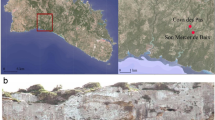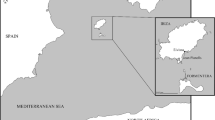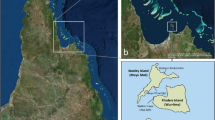Abstract
Tonga is a Polynesian island chain that was initially colonized by the Lapita culture about 2700 years ago. Its inhabitants went on to found the Tongan State about 700 years ago. Our project uses carbon and nitrogen stable isotope analyses to investigate and compare the diets of Lapita and Tongan State individuals. Sampled burial locations include the Talasiu shell midden cemetery dating to the Late Lapita period as well as four burial mounds on Tongatapu, Tonga, thought to date to the Tongan State period (700–100 BP) and two isolated burials. New bone collagen δ13C and δ15N results were obtained from 65 individuals and analyzed along with previously published carbon and nitrogen stable isotope results. Fifteen new radiocarbon dates on bone from five locations within Tongatapu are also reported. We show that low to moderate diagenesis in our samples tends to increase δ13C but does not have a directional bias for δ15N. Isotopic data that pass diagenesis checks strongly support a substantial marine component within the Late Lapita diet in Tonga, which is similar to the early Lapita diet at Teouma but differs from other Late Lapita data. Stable isotope and radiocarbon evidence indicate that Tongan State individuals had a more strongly terrestrial diet, and that elite and non-elite diets were similar during the Tongan State. We also show that the transition to a more terrestrial diet may have happened near the start of the Tongan State period.





Similar content being viewed by others
Data availability
All relevant human data is included in the article or Supplementary Material. Faunal isotope data is provided in Herrscher et al. (2018).
Notes
Petchey et al. (2011) actually report 1458 ± 3 BP, but it is clear from the context that 1458 ± 30 BP was intended.
References
Ambrose SH (1990) Preparation and characterization of bone and tooth collagen for isotopic analysis. J Archaeol Sci 17(4):431–451. https://doi.org/10.1016/0305-4403(90)90007-R
Anderson A, Chappell J, Gagan M, Grove R (2006) Prehistoric maritime migration in the Pacific islands: an hypothesis of ENSO forcing. Holocene 16:1–6
Bada JL, Schoeninger MJ, Schimmelmann A (1989) Isotopic fractionation during peptide bond hydrolysis. Geochim et Cosmochim 53:3337–3341
Bethard JD (2013) Isotopes. In: DiGangi EA, Moore MK (eds) Research methods in human skeletal biology. Elsevier, San Diego, pp 425–447
Bott E (1981) Power and rank in the Kingdom of Tonga. J Polyn Soc 90(1):7–81
Bronk Ramsey C (2009) Bayesian analysis of radiocarbon dates. Radiocarb 51:337–360
Brown TA, Nelson DE, Vogel JS, Southon JR (1988) Improved collagen extraction by modified Longin method. Radiocarb 30:171–177
Bruzek J (2002) A method for visual determination of sex, using the human hip bone. Amer J Phy Anthropol 117:157–168. https://doi.org/10.1002/ajpa.10012
Buckley HR (2000) Subadult health and disease in prehistoric Tonga, Polynesia. Amer J Phy Anthropol 113:481–505
Burley DV (1998) Tongan archaeology and the Tongan past, 2850-150 B.P. J World Prehist 12:337–392
Burley DV, Connaughton SP, Clark G (2018) Early cessation of ceramic production for ancestral Polynesian society in Tonga. PLoS One 13(2):e0193166. https://doi.org/10.1371/journal.pone.0193166
Burley D, Edinborough K, Weisler M, Zhao J-X (2015) Bayesian modeling and chronological precision for Polynesian settlement of Tonga. PLoS One 10(3):e120795. https://doi.org/10.1371/journal.pone.0120795
Clark G (2016) Chiefly tombs, lineage history and the ancient Tongan state. J Isl Coast Archaeol 11(3):326–343
Clark G, Burley D, Murray T (2008) Monumentality and the development of the Tongan maritime chiefdom. Antiquity 82:994–1008
Clark G, Grono E, Ussher E, Reepmeyer C (2015) Early settlement and subsistence on Tongatapu, Kingdom of Tonga: insights from a 2700–2650calBP midden deposit. J Archaeol Sci Rep 3:513–524. https://doi.org/10.1016/j.jasrep.2015.08.005
Clark G, Parton P, Reepmeyer C, Melekiola N, Burley D (2018) Conflict and state development in ancient Tonga: the Lapaha earth fort. J Isl Coast Archaeol 13:405–419
Clark G, Reepmeyer C, Melekiola N (2016) The rapid emergence of the archaic Tongan state: the royal tomb of Paepaeotelea. Antiquity 90(352):1038–1053. https://doi.org/10.15184/aqy.2016.114
Davidson JM (1969) Archaeological excavations in two burial mounds at ‘Atele, Tongatapu. Rec Auckland Inst Mus 6(4–6):251–286
Fenner JN, Clark G, Cressey A, Valentin F, Olesen SH, Armstrong R (2015) Isotopic uniformity and segregation in Tongan mounds. J Archaeol Sci Rep 2:644–653. https://doi.org/10.1016/j.jasrep.2014.11.008
Fernandes R, Nadeau M-J, Grootes PM (2012) Macronutrient-based model for dietary carbon routing in bone collagen and bioapatite. Archaeol Anthropol Sci 4:291–301
Freeland T, Heung B, Burley DV, Clark G, Knudb A (2016) Automated feature extraction for prospection and analysis of monumental earthworks from aerial LiDAR in the Kingdom of Tonga. J Archaeol Sci 69:64–74
Gifford EW (1929) Tongan society. Bernice P. bishop museum bulletin 60, Honolulu
Harbeck M, Grupe G (2009) Experimental chemical degradation compared to natural diagenetic alteration of collagen: implications for collagen quality indicators for stable isotope analysis. Archaeol Anthropol Sci 1:43–57
Hedges REM (2002) Bone Diagenesis: an overview of processes. Archaeometry 44:319–328
Herrscher E, Fenner JN, Valentin F, Clark G, Reepmeyer C, Bouffandeau L, André G (2018) Multi-isotopic analysis of first Polynesian diet (Talasiu, Tongatapu, Kingdom of Tonga). J Archaeol Sci Rep 18:308–317. https://doi.org/10.1016/j.jasrep.2018.01.012
High K, Milner N, Panter I, Penkman KEH (2015) Apatite for destruction: investigating bone degradation due to high acidity at Star Carr. J Archaeol Sci 59:159–168
Hogg AG, Hua Q, Blackwell PG, Niu M, Buck CE, Guilderson TP, Heaton TJ, Palmer JG, Reimer PJ, Reimer RW, Turney CSM, Zimmerman SRH (2013) SHCal13 southern hemisphere calibration, 0–50,000 years cal BP. Radiocarb 55(4):1889–1903. https://doi.org/10.2458/azu_js_rc.55.16783
Hollund HI, Teasdale MD, Mattiangeli V, Sverrisdottir OO, Bradley DG, O’Connor T (2017) Pick the right pocket. Sub-sampling of bone sections to investigate diagenesis and DNA preservation. Int J Osteoarchaeol 27(3):365–374. https://doi.org/10.1002/oa.2544
Institute of Medicine (2005) Dietary reference intakes for energy, carbohydrate, fiber, fat, fatty acids, cholesterol, protein, and amino acids. The National Academies Press, Washington
Jarić J (2004) Use of Pb and Sr isotopes in human teeth as an Indicator of Pacific Island population dynamics. PhD Dissertation, School of Science , Food and Horticulture, University of Western Sydney, Sydney, Australia
Jones S, Quinn R (2009) Prehistoric Fijian diet and subsistence: integration of faunal, ethnographic, and stable isotopic evidence from the Lau Island group. J Archaeol Sci 36(12):2742–2754. https://doi.org/10.1016/j.jas.2009.08.014
Kendall C, Eriksen AMH, Kontopoulos I, Collins MJ, Turner-Walker G (2018) Diagenesis of archaeological bone and tooth. Palaeogeogr Palaeoclimatol Palaeoecol 491:21–37. https://doi.org/10.1016/j.palaeo.2017.11.041
Kinaston RL, Bedford S, Spriggs M, Anson D, Buckley HR (2016) Is there a “Lapita diet”? A comparison of Lapita and post-Lapita skeletal samples from four Pacific Island archaeological sites. In: Oxenham M, Buckley H (eds) The Routledge handbook of bioarchaeology in Southeast Asia and the Pacfic Islands. Routledge, London, pp 535–574
Kinaston R, Buckley H, Valentin F, Bedford S, Spriggs M, Hawkins S, Herrscher E (2014) Lapita diet in remote Oceania: new stable isotope evidence from the 3000-year-old Teouma site, Efate Island, Vanuatu. PLoS One 9:e90376. https://doi.org/10.1371/journal.pone.0090376
Kirch PV, Kahn JG (2007) Advances in Polynesian prehistory: a review and assessment of the past decade (1993-2004). J Archaeol Res 15(3):191–238. https://doi.org/10.1007/s10814-007-9012-0
Lee-Thorp JA (2008) On isotopes and old bones. Archaeometry 50:925–950
Leach F, Quinn C, Morrison J, Lyon G (2001) The use of multiple isotope signatures in reconstructing prehistoric human diet from archaeological bone from the Pacific and New Zealand. New Zealand J Archaeolog 23:31–98
Longin R (1971) New method of collagen extraction for radiocarbon dating. Nature 230(5291):241–242
Makarewicz CA, Sealy J (2015) Dietary reconstruction, mobility, and the analysis of ancient skeletal tissues: expanding the prospects of stable isotope research in archaeology. J Archaeol Sci 56:146–158
Nunn PD, Carson MT (2015) Sea-level fall implicated in profound societal change about 2570 cal yr BP (620 BC) in western Pacific island groups. GEO: Geogr Env 2(1):17–32
O’Connell TC, Kneale CJ, Tasevska N, Kuhnle GGC (2012) The diet-body offset in human nitrogen isotopic values: a controlled dietary study. Am J Phys Anthropol 149:426–434
Petchey F, Clark G (2011) Tongatapu hardwater: investigation into the C-14 marine reservoir offset in lagoon, reef and open ocean environments of a limestone island. Quat Geochronol 6(6):539–549. https://doi.org/10.1016/j.quageo.2011.08.001
Petchey F, Spriggs M, Leach F, Seed M, Sand C, Pietrusewsky M, Anderson K (2011) Testing the human factor: radiocarbon dating the first peoples of the South Pacific. J Archaeol Sci 38(1):29–44. https://doi.org/10.1016/j.jas.2010.07.029
Pestle WJ, Colvard M (2012) Bone collagen preservation in the tropics: a case study from ancient Puerto Rico. J Archaeol Sci 39(7):2079–2090. https://doi.org/10.1016/j.jas.2012.03.008
Pestle WJ, Crowley BE, Weirauch MT (2014) Quantifying inter-laboratory variability in stable isotope analysis of ancient skeletal remains. PLoS One 9(7):e102844. https://doi.org/10.1371/journal.pone.0102844
Pietrusewsky M (1969) An osteological study of cranial and infracranial remains from Tonga. Rec Auckland Inst Mus 6:287–402
Pietrusewsky M, Douglas MT, Ikehari-Quebral RM, Lauer KK (2019) Skeletal and dental health of early Tongans: the bioarchaeology of the human skeletons from the To-At-36 site, Ha’ateiho, Tongatapu, Tonga. J Isl Coast Archaeol 15:204–243. https://doi.org/10.1080/15564894.2018.1564711
Poulsen J (1987) Early Tongan prehistory. Terra Australis 12. Department of Prehistory, the Australian National University, Canberra
R Core Team (2017) R: a language and environment for statisical computing (Version 3.4.1). R Foundation for Statistical Computing, Vienna Retrieved from www.R-project.org
Reiche I, Favre-Quattropani L, Vignaud C, Bocherens H, Charlet L, Menu M (2003) A multi-analytical study of bone diagenesis: the Neolithic site of Bercy (Paris, France). Meas Sci Technol 14:1608–1619
Reimer P, Bard E, Bayliss A, Beck JW, Blackwell PG, Ramsey CB, Grootes PM, Guilderson TP, Haflidason H, Hajdas I, Hatte C, Heaton T, Hoffman DL, Hogg AG, Hughen KA, Kaiser KF, Kromer B, Manning SW, Niu M, Reimer RW, Richards DA, Scott EM, Southon JR, Staff RA, Turney CSM (2013) IntCal13 and Marine13 radiocarbon age calibration curves 0–50,000 years cal BP. Radiocarb 55(4):1869–1887. https://doi.org/10.2458/azu_js_rc.55.16947
Richards MP, Hedges REM (1999) Stable isotope evidence for similarities in the types of marine foods used by late Mesolithic humans at sites along the Atlantic Coast of Europe. J Archaeol Sci 26:717–722
Roberts P, Fernandes R, Craig OE, Larsen T, Lucquin A, Swift J, Zech J (2018) Calling all archaeologists: guidelines for terminology, methodology, data handling, and reporting when undertaking and reviewing stable isotope applications in archaeology. Rapid Commun Mass Spectrom 32:361–372
Ruxton GD (2006) The unequal variance t-test is an underused alternative to Student’s t-test and the Mann-Whitney U test. Behav Ecol 17:688–690
Scheuer L, Black S (2000) Developmental juvenile osteology. Academic, Cambridge
Schwarcz HP (2014) Human physiology in relation to isotopic studies of ancient and modern humans. In: Holland HD, Turekian KK (eds) Treatise on geochemistry, 2nd edn. Elsevier, Amsterdam, pp 357–369
Scott RM, Buckley HR (2014) Exploring prehistoric violence in Tonga understanding skeletal trauma from a biocultural perspective. Curr Anthropol 55(3):335–347. https://doi.org/10.1086/676477
Snoeck C, Lee-Thorp J, Schulting R, de Jong J, Debouge W, Mattielli N (2015) Calcined bone provides a reliable substrate for strontium isotope ratios as shown by an enrichment experiment: strontium isotope ratios in calcined bone. Rapid Comm Mass Spectromet 29(1):107–114. https://doi.org/10.1002/rcm.7078
Spennemann DHR (1989) ‘Ata ‘a Tonga mo ‘ata ‘o Tonga: early and later prehistory of the Tongan Islands. Volume I: a study in settlement and subsistence patterns, with special emphasis on Tongatapu. PhD Dissertation, Department of Prehistory, The Australian National University, Canberra, Australia
Stantis C, Kinaston RL, Richards MP, Davidson JM, Buckley HR (2015) Assessing human diet and movement in the Tongan maritime chiefdom using isotopic analyses. PLoS One 10(3):e0123156. https://doi.org/10.1371/journal.pone.0123156
Tuross N, Fogel ML, Hare PE (1988) Variability in the preservation of the isotopic composition of collagen from fossil bone. Geochim Cosmochim Acta 52 (4):929–935
Tykot RH (2002) Contribution of stable isotope analysis to understanding dietary variation among the Maya. In: Jakes KA (Ed.), Archaeological Chemistry: Materials, Methods and Meaning, Vol. 831. American Chemical Society. pp. 214–230
Tykot RH (2004) Stable isotopes and diet: you are what you eat. In: Martini M, Milazzo M, Piacentini M (eds) . Physics Methods in Archaeometry. IOS Press, Amsterdam, pp 433–444
Ubelaker DH (1989) Human skeletal remains: excavation, analysis, interpretation. Taraxacum, Washington
USDA (2018) National Nutrient Database for standard reference. Release Date: 1 April 2018. https://ndb.nal.usda.gov/ndb/search/list. Accessed: 27 September 2018
Ussher E (2015) Agricultural development in Tongan prehistory: an archaeobotanical perspective. PhD Dissertation, School of Culture, History and Language, The Australian National University, Canberra
Valentin F, Clark G (2013) Early Polynesian mortuary behaviour at the Talasiu site, Kingdom of Tonga. J Pac Archaeolog 4(1):1–14
Valentin F, Clark G, Parton P, Reepmeyer C (2020) Mortuary practices of the first Polynesians: formative ethnogenesis in the Kingdom of Tonga. Antiquity. https://doi.org/10.15184/aqy.2020.89
van Dijk N (1993) The evolution of the Polynesian phenotype: an analysis of skeletal remains from Tongatapu, Tonga. Unpublished Masters Thesis, Auckland University, Auckland, NZ
van Dijk N (1998) The Melanesians: an osteological study of their biological relationships within the Pacific. PhD Dissertation, The Australian National University, Canberra
White CD, Armelagos GJ (1997) Osteopenia and stable isotope ratios in bone collagen of Nubian female mummies. Am J Phys Anthropol 103:185–199
Acknowledgments
Project investigations contributed to the development of the World Heritage nomination file for the Lapaha-Talasiu area requested by the Government of Tonga (Ministry of Tourism, Culture Division) and to the capacity of the Lapaha community to manage and record archaeological burial sites. We thank the Lapaha Community and Nobles (His Serene Highness Prince Kalaniuvalu Fotofili, Her Serene Highness Princess Marcella Taumoepeau Tupou Kalaniuvalu Fotofili, and Her Royal Highness Mele Siu’ilikutapu Kalaniuvalu Fotofili) and the Ministry of Internal Affairs (Government of Tonga). The Tongan Ministry of Internal Affairs granted permission for export and analysis of human remains for this project. Many of the ARCH8040 collagen extractions were performed by the students listed in supplemental Appendix 4. This research including archaeological excavation and isotopic analysis was funded by the MAEDI and CNRS for Frédérique Valentin and an Australian Research Council grant to Geoffrey Clark (FT0990591). All data that support the findings of this study are available in the online supplementary material published with this article or, for faunal comparisons, in Herrscher et al. (2018).
Funding
Australian Research Council grant was given to Geoffrey Clark (FT0990591); MAEDI and CNRS support was provided for Frédérique Valentin .
Author information
Authors and Affiliations
Corresponding author
Ethics declarations
Conflicts of interest
The authors declare that they have no conflict of interest.
Code availability
R scripts for statistical analyses are provided in the Supplementary Material.
Additional information
Publisher’s note
Springer Nature remains neutral with regard to jurisdictional claims in published maps and institutional affiliations.
Rights and permissions
About this article
Cite this article
Fenner, J.N., Herrscher, E., Valentin, F. et al. An isotopic analysis of Late Lapita and State Period diets in Tonga. Archaeol Anthropol Sci 13, 22 (2021). https://doi.org/10.1007/s12520-020-01267-z
Received:
Accepted:
Published:
DOI: https://doi.org/10.1007/s12520-020-01267-z




